Cassava can grow and produce reasonable yield, whereas many other crops fail. Fertilizers play an essential role in increasing production and ensuring healthy production by providing the soil with the right balance of nutrients. It is highly tolerant of low phosphorus levels and can usually grow even without phosphorus fertilizer because Cassava has established a mutually beneficial relationship with a group of earthly fungi. Let’s check out the best fertilizer for Cassava.
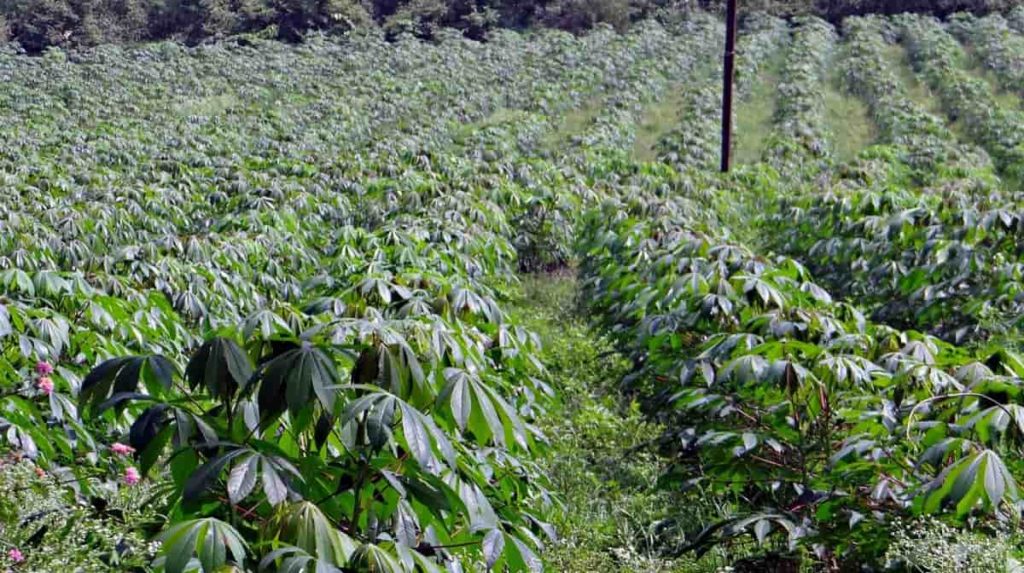
Cassava plants have a long growth period that requires adequate amounts of macronutrients, i.e., nitrogen, phosphorus, potassium, magnesium, and other nutrients, especially boron, manganese, zinc, and calcium, at certain times during the crop life cycle. Cassava is a heavy feeder crop that can cause severe depletion in soil nutrient stocks. Cassava should be fertilized with almost equal nitrogen, phosphorus, and potassium. The NPK balance will need to be amended to compensate for the removal of nutrients, especially potassium, in the crop. This compound can be done using fertilizers high in potassium and nitrogen and relatively low in phosphorus.
- Too much nitrogen causes Cassava to produce too many leaves.
- High quantity phosphorus costs are unnecessary. Cassava doesn’t need an overdose of phosphorus.
- Very little potassium, which Cassava needs to form roots. Cassava needs this nutrient very much.
Best fertilizer for Cassava
Homemade fertilizers for Cassava
Peanut cake
Soak two handfuls of Peanut cake in one liter of water for three to four days. The Peanut cake will then be fermented well. You can put this mixture under the plant to accelerate the growth of Cassava.
In case you miss this: Garden Trellis – Types, Ideas, Design, And Tips

Lime
Phosphorus is an essential nutrient that plants need to grow and thrive. Adding calcium carbonate to the soil, also known as liming, can make nutrients like phosphorus more available for plants. It can also make the soil less acidic, which helps Cassava crops grow and produce more edible roots.
Natural fertilizers for Cassava
Mulching is a helpful and straightforward that provides benefits to most crops. You can mulch the Cassava seedbed with dead plants. Use leaves from street crops, legume plants, and rice husks to cover the soil surface. It will block the light in the soil, maintain moisture level and make it difficult for the weeds to grow.
Compost manure for Cassava
Manure
Animal manures and composts are good sources of organic matter, which improve soil structure, enhance the ability to hold water, provide micronutrients and promote the underground activity of mud, bacteria, and fungi. Using various organic fertilizers such as cattle dung or poultry manure would improve soil fertility.
Organic and liquid fertilizers for Cassava
If your plants are growing taller before reaching maturity, use more chemical fertilizer in potassium for faster growth rates. Adding fertilizer and compost to your Cassava is the best way to prepare them for the crop. You can also add other organic soil supplements such as bone meal or fish emulsion.
Commercial fertilizers for Cassava
NPK ratio
There are two primary varieties of fertilizers, compound fertilizers that provide several nutrients together and single nutrient fertilizer, which provides only one nutrient. Compound fertilizers section deals with NPK fertilizers. Most of the NPK products represent a combination of these three nutrients in proportion, for example, NPK 15-15-15, NPK 17-17-17. As the relative ratio of three primary nutrients, N, P, and K, is fixed, NPK fertilizers are not ideal for Cassava.
In both using either 15-15-15 NPK or 17-17-17 NPK, though the amount supplied by nitrogen and potassium is correct, about five times more phosphorus is being provided than required, so the gardeners are wasting money by giving a lot of phosphorus. It is best if you supply the needed nutrients would be to replace NPK with single nutrient sources like urea, single Superphosphate (SSP), triple Superphosphate (TSP), diammonium phosphate (DAP), and Muriate of potash (MOP). Urea provides nitrogen; triple Superphosphate includes phosphorus, potassium chloride only potassium, DAP supplies mainly phosphorus and some nitrogen.
Cassava fertilizer schedule
Low soluble fertilizers, such as rock phosphate, lime, gypsum, sulfur, organic fertilizer, and compost, are broadcast throughout the field and added before planting to contact the soil and increase soil fertility. You should apply the total quantity of fertilizer required by NPK in three phases (also known as split): one-third of the total required amount should be applied four to six weeks after planting; for example, a total of 15-15-15 NPK of 400 kg should be used in three equal divisions, each approximately 133 kilograms, each distribution per plant should be about 15-15-15 of 13 grams of NPK.
In case you miss this: Vegetable Plant Spacing – A Full Guide
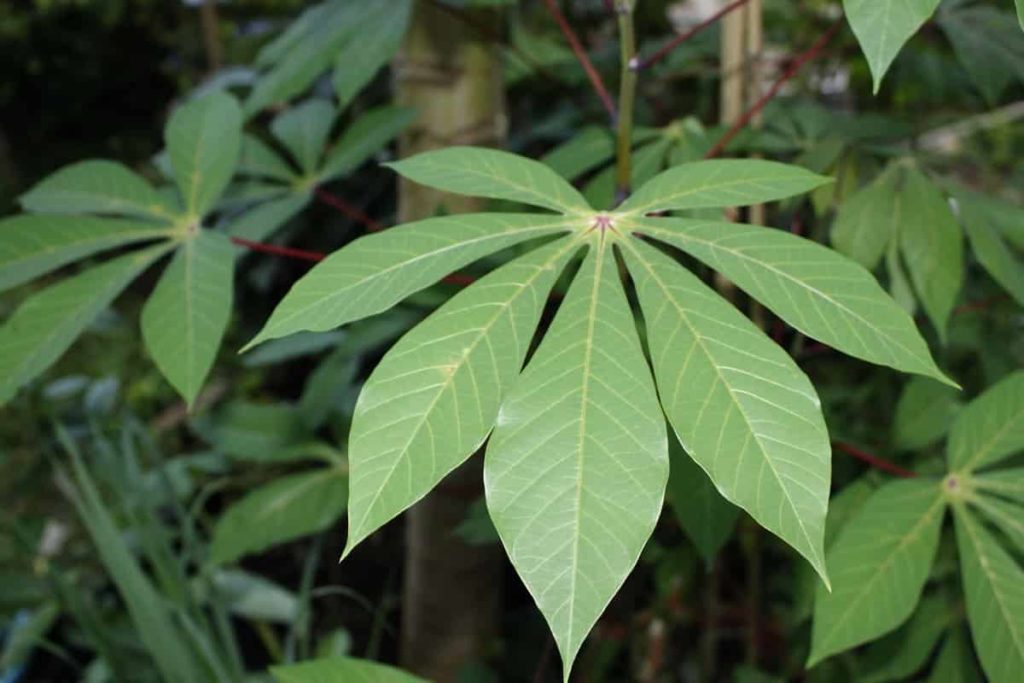
The second dressing (the same amount of fertilizer that is first distributed) should be applied 10 to 12 weeks after planting. The third dressing (then, the same amount of manure that is first and second distribution) is recommended 16 to 20 weeks after planting. However, it depends on the rainy season: it should not be applied before the rains stop. Using a small weeding hoe or similar tool, scratch a half-moon-shaped furrow 20 centimeters from the base of the Cassava plant.
Apply the correct measure of fertilizer to the furrow. Cover the applied fertilizer with soil. You should be scheduled for all three dressings at close intervals to supply all the fertilizer in the first season; if the second season’s rain is reliable, the final dressing can be applied after the second season’s rains. Later dressing using a hoe may not be appropriate because you may damage the roots of Cassava near the surface. In this case, fertilizer should be applied around Cassava in a 10 to 20 centimeters radius or semi-circle.
If Cassava is planted in wide rows and nearby distances within rows, fertilizer can also be closed with the Cassava row at 10 to 15 cm from the Cassava row. Some areas receive by-model rainfall allowing the first or second rain to be planted. Such sites need to schedule fertilizer applications according to the length of rains every season. If you planted Cassava at the start of a long rainy season followed by the first dressing, you should schedule two dressings in the first season and one in the second.
Only the first dressing should be applied if Cassava is planted at the beginning of the short rainy season, and You should give them in the next long season. However, gardeners should avoid consuming fertilizers too late as the consumption of nutrients in dry conditions is limited or can cause damage. Unlike NPK, where the ratio of different nutrients is determined using a combination of several single nutrient fertilizers, the exact amount of N, P, and K needed can be applied. Single nutrient fertilizers require more calculations but can be less expensive and more effective.
In case you miss this: Homemade Fertilizer for Tomato – Manure, Compost
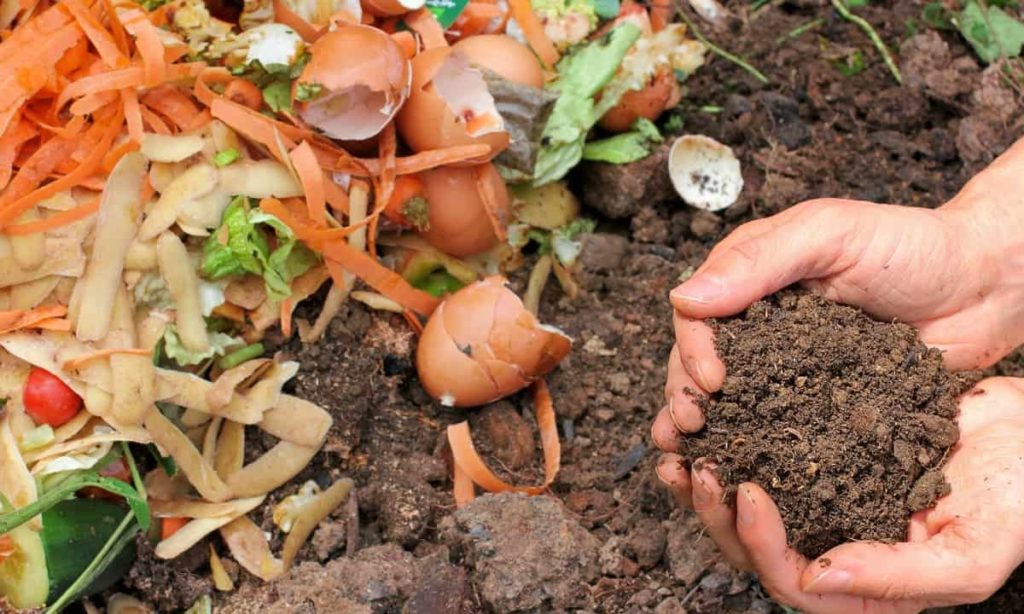
Frequently asked questions about Cassava farming (FAQ)
Is it hard to grow Cassava?
Cassava is relatively easy to grow, and a plant gives you a very generous crop because it grows from the same plant.
How to know when Cassava is ready to harvest?
You can dig Cassava’s tuber after 9 to 12 months. If your Cassava tubers can be left in the ground more than that, they can become wooden. The tubers are ready when the leaves turn yellow and fall after the stem has branched.
Can Cassava be planted in dry weather?
In two relatively short rainy season areas each year, Cassava can be planted in the early or medium part of the rainy season and after 10 to 14 months, preferably during dry weather.
How long does it take for Cassava’s root to grow?
It takes only six to eight months for the roots of the Cassava plant to be fully established.
How do you increase Cassava production?
At least four bags of fertilizer per hectare are guaranteed to increase production. The right concentration must be used, the mixing ratio should be done correctly, and at the time of spraying, there should be less sunlight to reduce evaporation.
In case you miss this: Homemade Fertilizer for Indoor Plants – Liquid & Solid
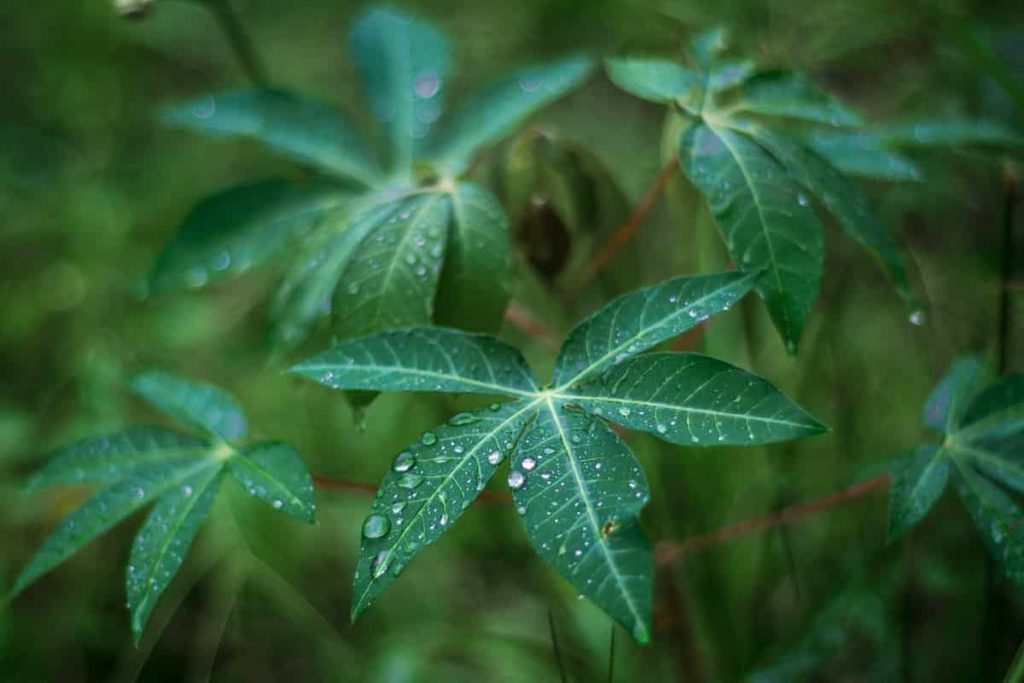
Why can farmers be able to produce Cassava without fertilizers?
Since most of the absorbed nutrients are found in Cassava stems and leaves, returning them to the ground helps maintain soil fertility for the next crop. Its ability to produce reasonable yields on poor lands has given rise to the belief that Cassava does not need or have to respond to mineral fertilizer.
What kind of soil is best for growing Cassava?
Cassava grows best on light sandy loams, which are moist, fertile, and deep, but it also performs well on the sand soil structure and relatively low fertility lands.
Does Cassava need too much water?
As a root crop, Cassava needs moisture in the first 3 to 4 months of its growth; therefore, soil sown with high water capacity at a high level of water for root absorption is vital for maximum production. However, it is essential to avoid water-filled conditions.
Where does Cassava grow best?
Growing Cassava successfully relies on a tropical climate and at least eight months of warm weather. This plant prefers well-drained soil and little rain, but it can survive where the soil is wet.
What kind of land preparation is suitable for Cassava?
Most farmers prefer to plant Cassava in well-prepared loose soil without weeds. It facilitates vertical or inclined planting and reduces the competition of early weeds.
What is Cassava’s bacterial disease?
Cassava Bacteria Flight is one of the most severe diseases of Cassava in many countries where the crop plays an important food and economic role. The disease is present in all the places that produce Cassava.
Is Cassava sprayed with pesticides?
Cassava farmers applied chemical pesticides to control the Cassava mealybug and Cassava White Fly.
In case you miss this: Homemade Fertilizers For Curry Leaf Plant (Organic)
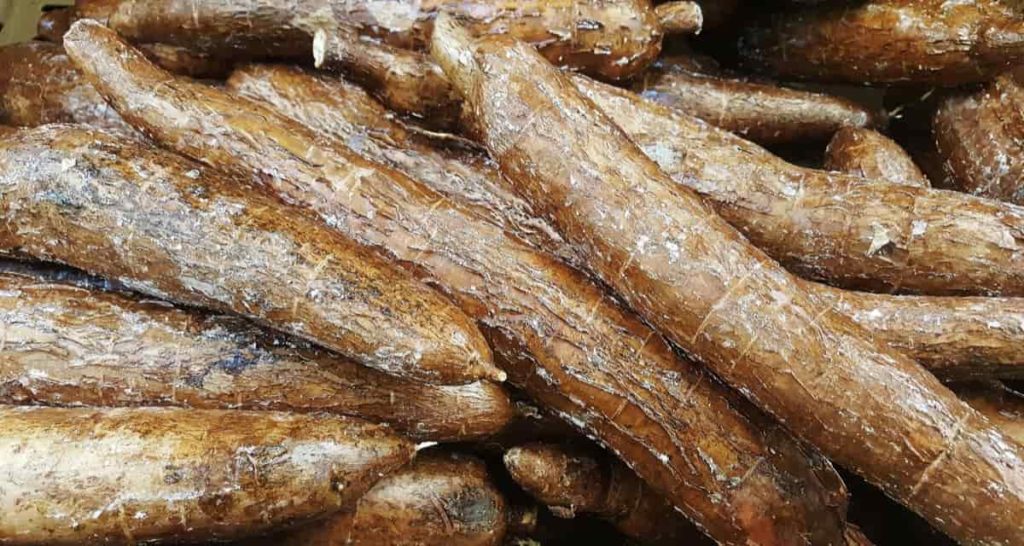
What is the economic importance of Cassava?
Cassava is a food crop, and also it is a significant source of cash income for producing households. As a cash crop, Cassava generates cash revenue for most households compared to other staples, which plays a positive role in poverty alleviation.
Which country is the biggest producer of Cassava?
Nigeria’s Cassava production is the largest globally; Benue is the top area in Nigeria in terms of Cassava production. Brazil has one-third more production, and Indonesia and Thailand almost double the production.
- Broccoli Seed Germination and Selection
- Asparagus Seed Germination and Variety Selection
- Seasonal Flower Gardening: Best Practices for Spring, Summer, Fall, and Winter
- How to Grow Hibiscus from Flower
- Plantation Ideas for Home Decoration: A Beginners Guide
- Flower Garden Designs and Layouts for Beginners
- Planting and Spacing Techniques in Papaya: A Beginner’s Guide
- Growing Gold: Essential Techniques for Planting Pineapples
- How to Make Kalanchoe Plant Bushy: Home Remedies and Solutions
- 11 Reasons Why Your Gardenia is Not Blooming: Home Remedies and Solutions
- Eco Elegance: The Guide to Designing a Drought-Tolerant Landscape
- Gardening on a Slope: Strategies for Hillside Landscaping
- Nourish and Flourish: Top Organic Mulches for Thriving House Plants
- Everything You Want to Know about Indian Mogra Flower: Discover Uses and Growing
- Green Thumb Success: Expert Tips for Cultivating Greenhouse Pumpkins All Year Round
- Maximize Growth & Flavor: The Ultimate Guide to Companion Planting in Herb Gardens
- How to Control Rhododendron Problems Naturally: Home Remedies and Organic Ways to Fix Them
- Natural Magic: The Remarkable Benefits of Cinnamon for Plants
- Best Steps to Revive Dying Tulip with Natural and Organic Treatment
- 10 Reasons Why Your Angel Trumpet is Not Blooming: Remedies and Treatment
- How to Fix Periwinkle Leaf and Flower-Related Problems: Natural Remedies and Solutions
- How to Fix Zinnias Leaf and Flower Problems: Discover Natural and Home Remedies
- Organic Steps to Induce Lemon Tree Flowers: A Comprehensive Guide
- Bloom Booster: Crafting the Perfect Homemade Bougainvillea Fertilizer
- Optimizing Growth: A Guide to Applying NPK Fertilizer for Potted Plants
- 10 Best Homemade Fertilizers for Rubber Plant: DIY Recipes and Application Method
- How to Boost Female Pumpkin Flowers: Effective Steps for More Flowers and High Yields
- Transform Your Indoor Garden: Top Benefits of Pink Salt for Houseplants
- 10 Best Homemade Fertilizers for Peacock Plants (Calathea): Easy DIY Guide
- Unlock Blooms: 9 Reasons Why Your Potted Chrysanthemum is Not Blooming
- 8 Reasons Why Your Potted Hibiscus is Not Blooming: Fix it with Simple Solutions
- Unlock Blooms: 9 Key Reasons Your Potted Frangipani Won’t Flower
- 10 Reasons Why Is My Ice Plant Not Blooming: Remedies and Treatment
- 10 Reasons Why My Potted Hydrangea Not Blooming: Treatment and Remedies
- 10 Reasons Why is My Wisteria Not Blooming: Remedies and Treatment
- 10 Reasons Why is My Goldfish Plant Not Blooming: Remedies and Treatment